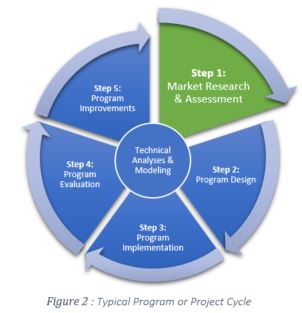 Baseline studies provide a snapshot of a particular aspect of a market at a given point in time. They consider factors such as existing technology densities and stocks, as well as the efficiency saturations. They also can serve as a benchmark against which to compare trends and developments over a course of time. These studies typically require the market to be characterized already in some form or another. Furthermore, because they are effectively a snapshot of that market, they require some narrowing of focus and may not include historical context or forecasts. Baseline studies are utilized for many downstream program activities such as estimating energy savings, and conducting potential assessments.
Baseline studies provide a snapshot of a particular aspect of a market at a given point in time. They consider factors such as existing technology densities and stocks, as well as the efficiency saturations. They also can serve as a benchmark against which to compare trends and developments over a course of time. These studies typically require the market to be characterized already in some form or another. Furthermore, because they are effectively a snapshot of that market, they require some narrowing of focus and may not include historical context or forecasts. Baseline studies are utilized for many downstream program activities such as estimating energy savings, and conducting potential assessments.
2014 Commercial Building Stock Assessment (CBSA): Anchor Blue team members were integral to the success of the PNW region’s most recent, large baseline study, the Commercial Building Stock Assessment for Northwest Energy Efficiency Alliance (NEEA). Completed in 2014 while Anchor Blue members were employed by Navigant Consulting, this study is one of the largest onsite building stock assessments completed to date, with over 1,400 buildings surveyed across the Pacific Northwest. Members of the Anchor Blue team were an integral part of this project, including:
- Project Management
- On-Site Field Visits
- Quality Control
- Data Analysis
- Sample Design
The full CBSA datasets and final report can be found at http://neea.org/resource-center/regional-data-resources. The Anchor Blue team has extensive experience analyzing all the Pacific Northwest regional data sources for market trends found at this link, as well as other market baseline sources in California[1] and the US EIA’s Energy Consumption Surveys[2], among others around the states.
In addition to CBSA, many of the Potential Studies that the Anchor Blue team have led required a small market baseline study to inform the measure level data required for Energy Efficiency Potential Studies.
